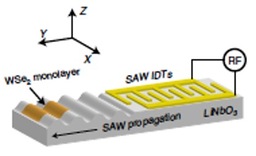Excitonic Devices for On-Chip Data Communication and Processing
TECHNOLOGY NUMBER: 2022-284

OVERVIEW
Room temperature excitonic devices for on-chip data communication and processing- One-dimensional waveguides which serve as wires and links for that data communication
- Provides an extinction ratio greater than 15 dB in devices with ~1.5 µm channel length
BACKGROUND
Coulombically bound electron–hole pairs, commonly known as excitons, provide an effective platform to transport energy at the nanoscale. Coupled with small dimension and seamless transition with photons, excitons have the potential to serve various applications in energy conversion, light emission, chemical sensing, and information processing and communication. With the recent emergence of two-dimensional semiconductors such as transition metal dichalcogenides (TMDs) that support excitons with high diffusivity and binding energy (>100meV), the feasibility of room-temperature excitonic devices is no longer questionable. However, the spatial manipulation of exciton flux that is critical to control energy flow at the nanoscale remains a challenge, especially at room temperature. Therefore, a need exists for improving the existing on-chip interconnect paradigm of using electrons through two-dimensional metal dichalcogenides.
INNOVATION
Researchers have discovered room temperature excitonic devices for on-chip data communication and processing. The technology includes one-dimensional waveguides which serve as wires and links for that data communication. The device uses Rayleigh-type surface acoustic waves to demonstrate controlled and directional exciton transport under the weak coupling regime at room temperature. The inventors have completed studies that confirm control over drifting excitons, a device that analogous to a switch or router, though about 100 times smaller. The exciton flux is manipulated by exerting an external electric field in the transverse direction utilizing a combination of stark shift and excitonic dissociation. The extinction ratio is greater than 15 dB in devices with ~1.5 µm channel length, providing a critical step toward achieving an optoexcitonics platform for data communicating and processing.
PATENT APPLICATION
Number:63/398,300
Status:Filed
-
expand_more mode_edit Inventor (3)Kanak DattaParag DeotareZidong Li
-
expand_more library_books References (1)
- Datta,., Lyu, Z., Li, Z. et al , Spatiotemporally controlled room-temperature exciton transport under dynamic strain. Nat. Photon. 16, 242-247 (2022). https://doi.org/10.1038/s41566-021-00951-3
-
expand_more cloud_download Supporting documents (1)Product brochureExcitonic Devices for On-Chip Data Communication and Processing.pdf